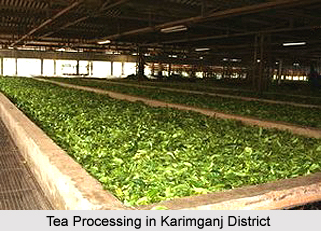 Economy of Karimganj District is mainly agriculture based. It is agrarian in character. However, developmental scenario of Karimganj district in Assam is not very bright. In fact, it is one of the most backward districts of India in terms of socio-economic development. One of the major reasons behind its economic backwardness is its remote location. Geographical remoteness of Karimganj district from the main part of the country along with poor communication and other poor infra-structural facilities are the main factors behind the low level of development of the region.
Economy of Karimganj District is mainly agriculture based. It is agrarian in character. However, developmental scenario of Karimganj district in Assam is not very bright. In fact, it is one of the most backward districts of India in terms of socio-economic development. One of the major reasons behind its economic backwardness is its remote location. Geographical remoteness of Karimganj district from the main part of the country along with poor communication and other poor infra-structural facilities are the main factors behind the low level of development of the region.
Work Force in Karimganj district
According to the Population Census in 2011, Karimganj District had population of 1,217,002. Out of which the male and female were 620,722 and 596,280 respectively. 70 percent of the population constitutes the non-workers section, hence making the district economically less productive. Major portion of the population is engaged in agriculture and allied activities like farming, fishing, forestry, horticulture etc. Industries (household as well as non-household), mining, construction works etc. all combine account for near about eight percent of the total main workers. Trade, commerce, transportation and communication account for almost 12 percent. The rest of the population (nearly 12 percent) is engaged in the service sector.
Primary Sector in Karimganj district
Primary sector of economy of Karimganj district includes agriculture, fishing, forestry, plantation and farming. Economy of Karimganj district is agrarian in character with as much as 60 percent of the active workforce engaged in cultivation. The Primary sector of economy engages 68 percent of active workforce. However, the net area sown has remained more or less stagnant for years due to low rate of multiple cropping, which again, is the result of poor irrigation facility, even though three perennial rivers, large swamps and watersheds feed the district. Therefore, the productivity in the district is rather low. Tea and rubber are major plantation crops of the district. Rubber plantation in the district is relatively new and occupies only a fraction of the land. Most of tea and almost whole of the rubber output is exported.
Karimganj District has huge potential for fishery, being endowed with a large number of rivers, swamps, ponds and other natural water bodies. There are 49 registered beels (small water bodies) and about 23,535 smaller ponds and lakes. In spite of all these, the district is far from being self-sufficient in fish production. Large quantities of fish are imported from states like Uttar Pradesh, Andhra Pradesh and also from Bangladesh. Livestock and poultry occupy an important position in the rural economy and also act as household assets. However, egg production in the district is deficient and therefore has to be imported from other states in large quantity.
Further, timber, bamboo, cane, stone and sand are the major forest products of Karimganj district. Almost 30 percent of the total area of district is occupied by forests. The forests are rich in various costly timbers like teak, sundi, gamari etc. Huge quantity of bamboo is harvested and supplied regularly to paper mills of Hailakandi District. However, in the last few years, restrictions have been imposed on cutting of trees to prevent large scale deforestation and consequently, timber production has gone down considerably.
Secondary Sector in Karimganj district
Secondary sector of the economy of Karimganj district includes several industries. However, there is no large or medium scale industry in the district. A number of industries like textiles, polythene etc. set up in the Badarpur Industrial Estates a few years back have mostly closed down due to infra-structural problems. All existing industries in the district are in small or cottage sector. Tea processing, food products, bamboo and cane products, saw and plywood, weaving etc. are the industries comprising the entire secondary sector of economy of Karimganj district. Cane furniture, mats, and decoration pieces manufactured in the cottage industries of this district are supplied to all over the country and are in great demand all over. Moreover, Oil and Natural Gas Corporation (ONGC) has been engaged in exploration works at several drilling sites in the district.
Tertiary Sector in Karimganj district
Tertiary sector of Karimganj district is a key sector constituted by construction, trade and commerce, transport and communication and other services. According to the Census report held in 2001, around 9 percent of the active workforce in Karimganj district is engaged in trade and commerce. Karimganj has to depend on the supply from rest of the country for most of the items of daily need, such as food grains, spices, sugar and other food items, textiles and garments, construction materials, automobiles and auto-parts, stationery items and so on. However, international trade with Bangladesh has picked up considerably in the recent years and promises to grow further.
The district suffers from lack of infrastructure and poor communication facilities. Agriculture, which is the main sector of economy, is primitive in nature with poor productivity. In the other sectors too, lack of entrepreneurship, low credit-deposit ratio, erratic electricity, unusable roads, periodic floods etc. have affected the development. However, there is enough scope for development as far as economy of Karimganj district is concerned. It can be made possible if the inherent strengths and unique advantages are adequately harnessed. Vast forest reserve, huge potential for fishery, horticulture and other agro-based industries, possible natural gas reserve and also immense possibility of border trade with Bangladesh - provide a bright hope for enhancement of economic of Karimganj district.



















